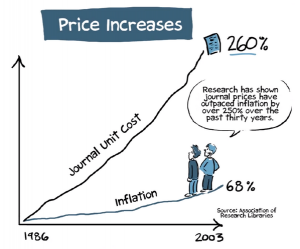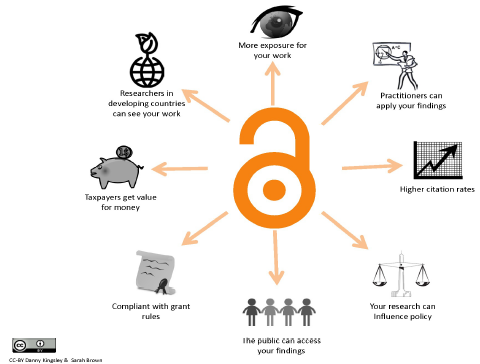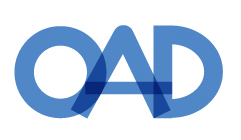Open access is a matter of publishers and paywalls, research and restrictions, copyright and creative commons. Just last week, librarians and information professionals of all stripes spoke out in support of open access publishing, as part of International Open Access Week 2014. Open access publishing is an often-overlooked issue that has an outsized impact on everyone—academics, publishers, scientists, medical practitioners, students, and even the everyday person-on-the-street.
When an academic paper is published in a subscription journal, it’s traditional for the publisher to assume control of the paper’s copyright, and release the paper only to those institutions that pay a subscription fee. Unfortunately, as The Guardian notes, “the price of journals has exploded. Harvard, the richest university in the world, says it can’t keep up and has started cutting subscriptions. This is happening everywhere.” It’s already extremely difficult for members of the public who aren’t affiliated with major universities to access many traditionally published papers. Now that universities are being priced out of the game too, even those who’d normally have full access are finding themselves wanting.

Most cutting-edge research in the US is funded in some way by the federal government and, ultimately, the tax-paying public. When access to these papers is restricted to wealthy institutions, members of the general public who contribute to the process are unable to see the results. Though public libraries do their best to provide access to major databases, when high-powered schools like Harvard can’t keep up, it’s hard to imagine public libraries’ comparatively smaller budgets being sufficient. Oftentimes, new research contains information with the power to potentially change the lives of regular people, but they aren’t able to see it or make use of it.
Proponents of open access are working on ways to curb these problems. An open access paper is one which can be accessed on the internet for free, with no restrictions on who can view and download it. In its purest form, sometimes called libre open access, it guarantees that papers are subject to less restrictive copyright controls. Libre open access papers let users “copy, use, distribute, transmit and display the work publicly and to make and distribute derivative works, in any digital medium for any responsible purpose, subject to proper attribution of authorship…” Not all open access papers have this quality, but it is generally striven for.
There are any number of ways for an author to release their paper as open access, but two paths are the most common. First off, in the last decade we’ve seen a proliferation of new open access journals entering the picture. An open access journal does not place any restrictions on who can access its contents, and does not charge a fee for access. Its contents are available for free on the internet. Open access journals still conduct peer review, so there is still robust quality control on what gets selected for inclusion. Open Access Journals are funded in a variety of ways. Some accept author fees, some are funded by an institution, some feature advertising, et cetera. The Directory of Open Access Journals indexes all open access journals to facilitate discovery.
The other most popular way of releasing an open access paper is to place it in an open repository or archive. Repositories don’t peer review papers or institute any other method of quality control. They mainly serve as a simple access point for papers, though they also often do what they can to provide long-term preservation as well. An open repository is accessible to anyone, without restrictions. Even if a paper has been published by a closed journal, if the original author has retained the paper’s copyright then she or he can still put it in an open repository without consequence. Traditionally, closed journals retain a paper’s copyright, but as part of the push for open access many authors have insisted on retaining control of the copyright when publishing.
Open access does more than just help people read your paper. It also allows more options for its usage. In his article on Massive Open Online Course syllabuses, Simmons SLIS alumnus Kyle Courtney points out that MOOCs don’t have the same legal fair-use protections that regular university courses do, making it very hard to assign readings. Because a MOOC’s students are not necessarily enrolled in the college, it’s considered copyright infringement for the school to provide them access to articles from closed journals and databases. In some cases, instructors can’t even share their own writing without breaking the law, as they’d assigned their copyright to a publisher upon publication. In his article, Courtney recommends four different strategies for solving this problem, and the strongest of them involve open access. He recommends using open access articles in MOOCs, and either publishing your paper as open access in the first place, or striking a contractual deal with your publisher allowing you the rights to your own open access copy of the paper for unrestricted use in the future. This way, you maximize availability to course readings for students who may not have access to closed databases or the money to purchase assigned texts.

The American Library Association officially supports the open access movement, and has published a handy briefing summarizing it and explaining its relevance for librarians. It includes this pretty definitive list of ways that librarians can support the open access movement:
- Plan workshops for faculty about why open access is important to them and what they should know when publishing.
- Advocate for the inclusion of open-access journals in the pool of publications used when evaluating for tenure.
- Educate public library users on how open-access issues impact their ability to access pertinent information, particularly medical and other scientific information.
- Encourage the use of open-access repositories and journals by including them in our electronic resources, LibGuides and other local information sources.
- Promote the copyright rights of authors by educating faculty on negotiating with publishers regarding the deposit of published articles in digital repositories for access and preservation.
- Avoid looking at open access as a “technology issue.” Open access is as much an information freedom issue, and librarians outside of digital collections, scholarly communications and IT departments are needed to engage with stakeholders, both representing their interests to the library and educating them about open-access issues.
- Subscribe to discussion lists and use RSS feeds to remain abreast of changes and advancements in the open-access movement.
- Learn about the relationship between open access and copyright.
- Remind patrons that if they pay federal taxes, they have funded federal research, including research conducted by federal grant recipients.
The open access movement appears to be making good progress, as Nature’s news blog recently announced that more than half of research articles published from 2007-2012 are now free to read. Hopefully we’ll see this trend increasing in the future as early-career researchers stick to their guns on open access.

P.S. For further information on open access, please see Peter Suber’s extremely thorough and elegant overview of the subject, as well as Simmons SLIS’s own Open Access Directory, which links to a panoply of related resources. Also of interest is Jill Walker Rettberg’s explanation of how she was able to publish a full scholarly book with an open access license.
(Post by Derek Murphy)
Lukay nakliyat olarak kurulduğu bu günden istanbulun tüm ilçelerinde hizmet vermekteyiz. uygun fiyat imkanları sunan firmamız geniş araç filosu ile istanbulun tüm ilçelerinde hizmet vermeye devam etmektedir. üstü açık ve üstü kapalı kamyonetler mevcut olup yanı sıra çelik kasa, kayar perdeli gibi kamyonetlerimizde mevcuttur. araç talebinde bulunmak için bizlere 7/24 ulaşım sağlayıp kaliteli ve güvenilir hizmetimizden faydalanabilirsiniz.
İSTANBUL ŞEHİR İÇİ HALKALI NAKLİYAT FİRMASI
İSTANBUL ŞEHİR İÇİ YENİBOSNA NAKLİYT FİRMASI
Thanks for the useful content.
Thank you, it’s a nice content.
Thank you, it’s a nice content.
Thanks for the useful content.
Open access publishing is essential to ensuring that publicly funded research remains publicly accessible, fostering transparency, equity, and broader scholarly impact. As the cost of academic journal subscriptions continues to rise beyond the reach of even elite institutions, it is increasingly clear that traditional publishing models are unsustainable and exclusionary. The momentum behind open access reflects not only a technological shift but a fundamental ethical imperative to democratize knowledge.